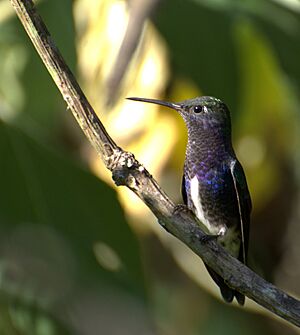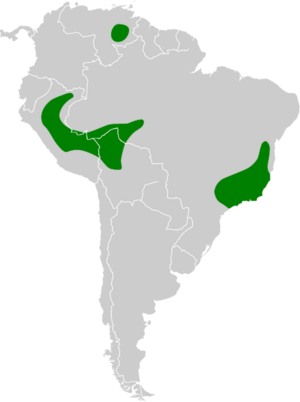Sapphire-spangled emerald facts for kids
Quick facts for kids Sapphire-spangled emerald |
|
|---|---|
 |
|
| Conservation status | |
| Scientific classification | |
| Genus: |
Chionomesa
|
| Species: |
lactea
|
 |
|
| Synonyms | |
|
|
The sapphire-spangled emerald (Chionomesa lactea) is a beautiful type of hummingbird. It belongs to a group of hummingbirds often called "emeralds."
You can usually find this bird in countries like Bolivia, Brazil, Peru, and Venezuela. Sometimes, it travels to Argentina as a "vagrant," meaning it's not usually found there. There might also be some in Ecuador, but this is not fully confirmed.
Contents
About Its Name and Family
Scientists group living things into families, just like your own family has different members. This is called taxonomy. The sapphire-spangled emerald has had a few different scientific names over the years.
It was once placed in the Hylocharis and Polyerata groups. Until 2014, it was mostly known as part of the Amazilia group. But scientists studied its DNA and found that the Amazilia group was not organized in the best way.
So, they moved the sapphire-spangled emerald and another bird, the glittering-throated emerald, into a group called Chionomesa. This group was actually first named in 1921! However, some groups of scientists still keep it in Amazilia.
Most scientists agree that there are three types, or subspecies, of the sapphire-spangled emerald:
- C. l. zimmeri
- C. l. lactea (This is the main type, called the "nominate subspecies")
- C. l. bartletti
Some scientists think that C. l. bartletti should be its own species, called the spot-vented emerald. They also think C. l. zimmeri might be a separate species. But for this article, we will follow the idea that there are three subspecies.
What It Looks Like
The sapphire-spangled emerald is a small bird, about 8 to 11 centimeters (3 to 4 inches) long. It weighs between 3.6 and 5 grams (about the weight of two pennies).
Both male and female birds have a medium-sized, straight beak. The top part of the beak is blackish. The bottom part is pinkish or horn-colored, with a dark tip.
Males of the Main Type (C. l. lactea)
Male birds of the main type have shiny golden-green or bronze-green feathers on their back and head. Their throat and upper chest are a bright, sparkling violet-blue. The middle of their lower chest is white, and their belly is grayish. The feathers under their tail are whitish with brown stripes.
Their central tail feathers are shiny green or bronze-green at the base, getting darker towards the end. The outer tail feathers are bluish-black.
Females of the Main Type (C. l. lactea)
Female birds look similar to males. However, their throat is grayish with sparkling turquoise spots. Their outermost tail feathers have grayish tips. Young birds look like adult females but have more gray on their undersides.
Differences in Other Subspecies
- C. l. zimmeri males: These males have a smaller patch of sparkling violet-blue on their throat. It does not go down onto their chest as much as in the main type.
- C. l. zimmeri females: Their throat and belly are whiter than the main type.
- C. l. bartletti males: They have a brighter green head than the main type. Their throat feathers have a grayish edge. The middle of their belly is greenish, and the lower belly is grayish. They have a lot of brown on the feathers under their tail.
- C. l. bartletti females: They look like the males but are not as bright. Their throat and chest have white and gray spots. Their belly is whiter than the main type.
Where It Lives
The three subspecies of sapphire-spangled emerald live in different areas.
- C. l. zimmeri: This subspecies lives the farthest north. You can only find it in the Bolívar state in southeastern Venezuela.
- C. l. lactea: This main type lives in eastern Brazil. It ranges from Bahia south through Minas Gerais, Rio de Janeiro, and São Paulo into Paraná. It has also been seen in northern Argentina, but only rarely.
- C. l. bartletti: This subspecies lives in eastern and southeastern Peru, northern Bolivia, and nearby western Brazil. There is one report of it in eastern Ecuador, but it is not fully confirmed.
These hummingbirds generally like to live in places that are partly open. This includes the edges of rainforests, forests along rivers, and areas where trees have grown back after being cut down. They also like river edges and clearings.
They mostly live at elevations below 1,000 meters (about 3,300 feet). However, in Venezuela, they live in a specific range between 1,100 to 1,400 meters (about 3,600 to 4,600 feet). The C. l. lactea subspecies also lives in open grasslands, rocky fields, parks, and gardens. It is usually found near sea level but can be seen as high as 1,300 meters (about 4,300 feet) in some places.
Behavior
Movement
The sapphire-spangled emerald in eastern Brazil (C. l. lactea) moves short distances from north to south during different seasons. This movement seems to be linked to when its favorite flowers are blooming. Scientists do not know if the other two subspecies move around in the same way.
Feeding
The sapphire-spangled emerald drinks nectar from many different kinds of flowers, shrubs, and trees. Some of its favorite plant families include peas, mallows, heliconias, bromeliads, and coffee plants. It also gets nectar from verbena and loosestrife plants.
Male birds will protect their feeding areas from other birds. Besides nectar, these hummingbirds also eat insects. They catch insects by flying out from a perch, grabbing the insect, and then returning to their perch. This is called "hawking."
Reproduction and Life Cycle
The sapphire-spangled emerald's breeding season seems to be from October to January. The female bird builds a cup-shaped nest using soft plant fibers and spiderwebs. She decorates the outside with lichen. The nest is usually placed like a "saddle" on a small branch.
The female lays two eggs and sits on them for about 14 days to keep them warm. The baby birds leave the nest about 22 to 23 days after they hatch.
Vocalization
The song of the sapphire-spangled emerald sounds like a buzzing, insect-like, high-pitched trill. It might sound like "tzee … tzitzitzee … tzitzitzee … tzitzitzee" or "tseeririri...tseeririri…." It also makes "tsip" and "chup" call sounds.
Conservation Status
The International Union for Conservation of Nature (IUCN) looks at the sapphire-spangled emerald and the "spot-vented" emerald separately. Both are considered to be of "Least Concern." This means they are not currently in danger of disappearing.
The exact number of these birds is not known, but their populations are thought to be decreasing. However, no major immediate threats have been found for either bird. The sapphire-spangled emerald is common to very common in most places it lives. It is fairly common in Peru and not very well known in Bolivia. The C. l. zimmeri subspecies is only found in a few separate spots within its small range.
On Money
The sapphire-spangled emerald was once pictured on the back of the 1-Brazilian Real banknote, which is no longer used.


